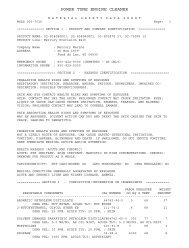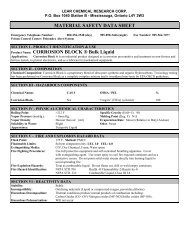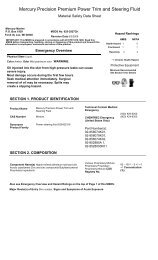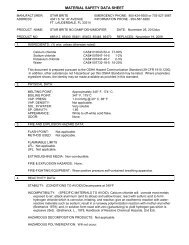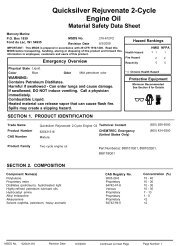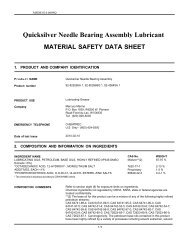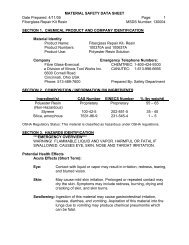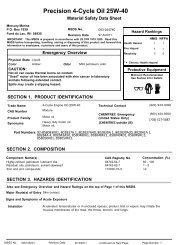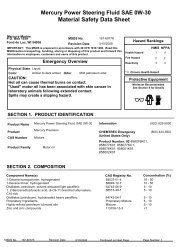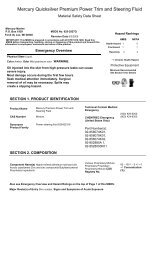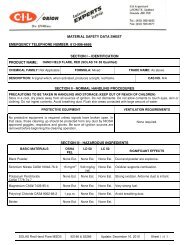Power Tune Engine Cleaner - Kellogg Marine Supply
Power Tune Engine Cleaner - Kellogg Marine Supply
Power Tune Engine Cleaner - Kellogg Marine Supply
You also want an ePaper? Increase the reach of your titles
YUMPU automatically turns print PDFs into web optimized ePapers that Google loves.
MERCURY PRECISION PARTS Mercury <strong>Marine</strong> MSDS 005-6074C<br />
Product: <strong>Power</strong> <strong>Tune</strong> <strong>Engine</strong> <strong>Cleaner</strong> (Canadian Product)<br />
Product #: 92-75995 12<br />
SECTION I - MANUFACTURER INFORMATION<br />
Name: Shrader Canada Ltd. Emergency: 613-996-6666 (Canutec)<br />
Address: 830 Progress Court Information: 800-201-9486<br />
Oakville, Ontario Date Prepared: 09-19-02<br />
L6L 6K1<br />
Revised:<br />
SECTION II - HAZARDOUS INGREDIENTS/IDENTITY INFORMATION<br />
Hazardous Components* OSHA PEL ACGIH TLV Other % (Opt.)<br />
Oleic Acid (112-80-1) N/D N/AV 5-10<br />
Methylisobutyl Carbinol (108-11-2) N/D 25ppm 3-7<br />
2-Butoxyethanol (111-76-2) N/D 20ppm 3-7<br />
Ammonia Solution (1336-21-6) N/D N/AV 1-5<br />
*Specific Chemical Identity, Common Name (CAS)<br />
SECTION III - PHYSICAL/CHEMICAL CHARACTERISTICS<br />
Boiling Point: Wide Range Specific Gravity (H 2 0=1): 0.89-0.92 @ 15°C<br />
Vapor Pressure (mmhg): N/AV<br />
Melting Point: N/D<br />
Vapor Density (Air=1): > 1<br />
Evaporation Rate: N/AV<br />
Solubility in Water: Partial<br />
(Butyl Acetate=1)<br />
Appearance and Odor: Amber liquid; No odor info HMIS Rating: H-2 F-4 R-1 P-Section VIII<br />
SECTION IV - FIRE AND EXPLOSION HAZARD DATA<br />
Flash Point (Method Used): 44°C (TCC)<br />
NFPA Rating: N/D<br />
Flammable Limits: LEL – N/AV UEL – N/AV<br />
Extinguishing Media: Large Fires: Alcohol foam or water fog. Small Fires: Carbon dioxide or dry<br />
chemical.<br />
Special Fire Fighting Procedures: Use water spray to cool fire-exposed containers and prevent bursting.<br />
Do not use a direct stream of water. Flammable. Sprayed product will project flame on contact with an<br />
ignition source. Contents under pressure. Containers can build up pressure if exposed to heat (fire).<br />
Vapours are heavier than air and may travel or may be moved along the ground to an ignition source at<br />
locations distant from material handling.<br />
Unusual Fire and Explosion Hazards: N/D<br />
SECTION V - REACTIVITY DATA<br />
Stability: Unstable ( ) Stable (X)<br />
Conditions to Avoid: Avoid excessive heat, sparks, and open flame.<br />
Incompatibility (Materials to Avoid): Avoid strong oxidizers such as HOOH (hydrogen peroxide), HNO3<br />
(nitric acid), and oleum<br />
Hazardous Decomposition or Byproducts: Carbon dioxide, carbon monoxide, and other unidentified<br />
organic compounds.<br />
Hazardous Polymerization: May Occur ( ) Will Not Occur (X)<br />
ADDITIONAL INFORMATION<br />
Distributed by: Mercury <strong>Marine</strong> Emergency: 905-567-6372 Ext. 4701<br />
2395 Meadowpine Blvd. Information: 905-567-6372 Ext. 4701<br />
Mississauga, Ontario, Canada
Mercury <strong>Marine</strong> MSDS 005-6074C<br />
SECTION VI - HEALTH HAZARD DATA<br />
Route(s) of Entry: Inhalation (Y) Skin (Y) Eye (Y) Ingestion (Y)<br />
Health Hazards (Acute and Chronic): Chronic overexposure to 2-Butoxyethanol may cause liver, kidney,<br />
and blood damage. Reports have associated repeated and prolonged occupational overexposure to various<br />
organic solvents with internal organ, brain, and nervous system damage.<br />
Carcinogenicity: NTP (N) IARC Monographs (N) OSHA Regulated (N)<br />
Signs and Symptoms of Exposure: Inhalation – High concentrations may cause respiratory irritation and<br />
central nervous system depression with results ranging from dizziness and headache to unconsciousness.<br />
Skin – 2-Butoxyethanol may be absorbed through the skin. Frequent or prolonged contact may dry and<br />
irritate the skin and cause a rash. Methyl Isobutyl Carbinol may be absorbed through the skin. No hazard<br />
under normal conditions of use. Xylene may be absorbed through the skin. Eye – Direct contact causes eye<br />
irritation. Symptoms include pain, redness, and tearing. Vapours will irritate the eyes. Ingestion –<br />
Aspiration into the lungs during swallowing or subsequent vomiting may cause chemical pneumonitis,<br />
which can be fatal. Ingestion of large amounts may cause stomach irritation. Ingestion of small amounts<br />
during normal handling is not likely to cause injury. Larger amounts may cause effects similar to those<br />
described under inhalation. Symptoms include nausea, vomiting, and diarrhea.<br />
Medical Conditions Generally Aggravated by Exposure: N/D<br />
Emergency and First Aid Procedures: Inhalation – If inhaled, remove victim from area to fresh air. Get<br />
medical attention if respiratory irritation develops or it breathing becomes difficult. Skin – Remove<br />
contaminated clothing. Wash affected skin with soap and water. Seek medical attention if irritation persists.<br />
Launder clothing before reuse. Eye – Immediately flush eyes with large amounts of water for at least 15<br />
minutes, lifting upper and lower lids. Get medical attention if irritation persists. Ingestion – DO NOT<br />
INDUCE VOMITING! Drink two glass of water if conscious. Call a physician.<br />
SECTION VII - PRECAUTIONS FOR SAFE HANDLING AND USE<br />
Steps to be Taken in Case Material is Released or Spilled: Wear suitable protective clothing. Follow<br />
applicable explosion and fire precautions during the response. Contain spilled material. Stop the spill at the<br />
source when safe to do so. Avoid contamination of natural waterways. Large Spills: Dike the area to<br />
prevent spreading. Pump excess to a salvage container. Absorb residues with non-flammable absorbent<br />
material and collect absorbent for disposal. Refer to the environmental ministry. Small Spills: Absorb<br />
small spills with non-flammable absorbent material and collect adsorbate for disposal.<br />
Waste Disposal Method: Reuse or recycling should be given priority over disposal under any<br />
circumstances. Do not dump unused contents into sewers, on the ground, or into any body of water.<br />
Dispose of in accordance with municipal, provincial, and federal regulations.<br />
Precautions to be taken in Handling and Storing: Containers of this material may contain hazardous<br />
residues when emptied. Do not cut, weld, drill, or grind on or near this container. Avoid smoking, eating,<br />
and drinking during use. Keep away from heat, spark, flame and other sources of ignition. Contents under<br />
pressure. Store in a cool, dry, well-ventilated area. Storage temperatures should not exceed 40°C. Keep<br />
from freezing.<br />
Other Precautions: KEEP AWAY FROM CHILDREN!<br />
SECTION VIII - CONTROL MEASURES<br />
Respiratory Protection (Specify Type): Not normally required. If TLV is exceeded, a NIOSH-approved<br />
respirator is advised.<br />
Ventilation: Local Exhaust & Mechanical: Sufficient mechanical ventilation to maintain exposures<br />
below the TLV. General mechanical ventilation is not recommended as the sole means of controlling<br />
exposure. Make-up air should always be supplied to balance air exhausted.<br />
Protective Gloves: Nitrile gloves. Neoprene.<br />
Eye Protection: Safety glasses. Contact lenses should not be worn. They may contribute to the severity of<br />
the injury.
Mercury <strong>Marine</strong> MSDS 005-6074C<br />
SECTION VIII - CONTROL MEASURES (cont.)<br />
Other Protective Clothing or Equipment: Sufficient clothing to prevent skin contact. Emergency shower<br />
and eye wash facility should be nearby.<br />
Work/Hygiene Practices: Always follow good housekeeping and personal hygiene practices.<br />
N/D = NOT DETERMINED (NO DATA) N/E = NONE ESTABLISHED Y = YES<br />
N/A = NOT APPLICABLE N/AV = NOT AVAILABLE N = NO



